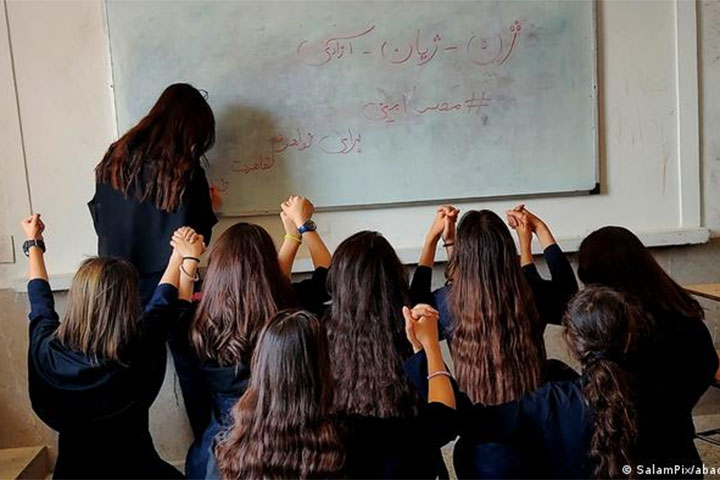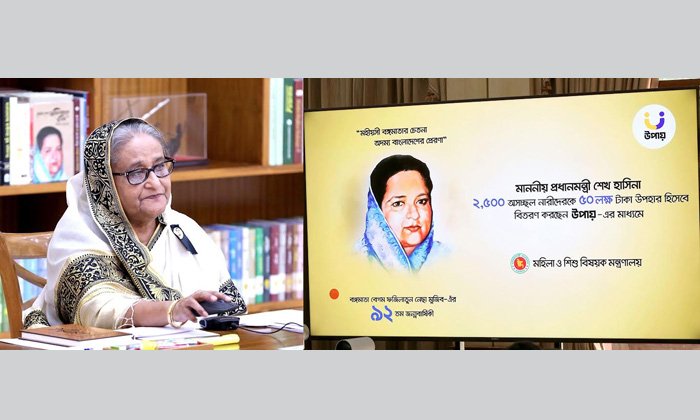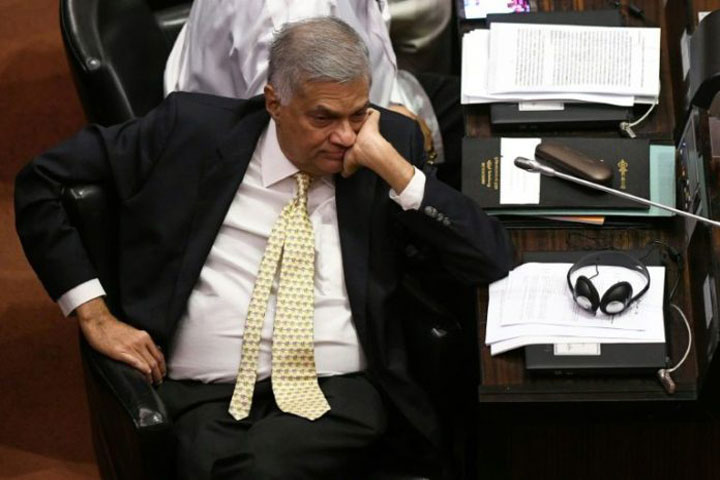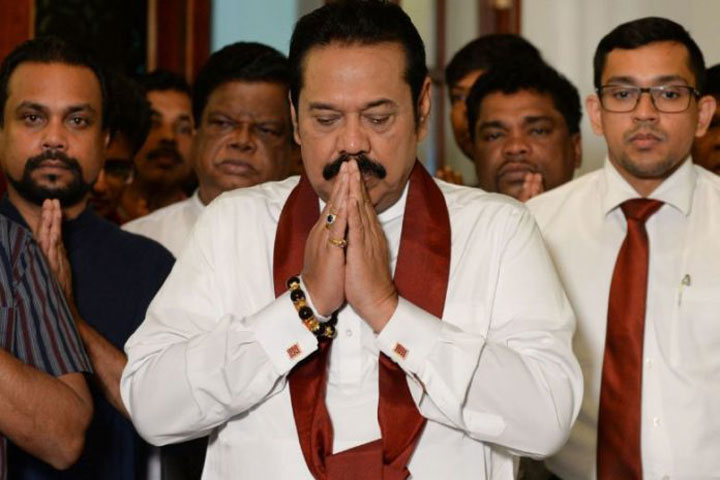Iran protests a struggle for self-determination
Students in a girls' school in Tehran remove their headscarves in protest against the Iranian government
The uprising in Iran is feminist. After all, feminism isn't about putting women in power instead of men. It is about self-determination for all, men and women alike. And today's protesters regard the enforced wearing of the hijab as a symbol of the state's refusal to grant them self-determination.
This right covers much more than "just" the right to dress as you like; it means the 50% of Iranians whose first language isn't Farsi being allowed to learn their first languages in schools; it means lesbians and gay men being able to freely express their sexual orientation; it means the Bahai being allowed to practice their religion — and so on.
The artist Shervin Hajipour's song "Baraye" (meaning "for" or "because"), which has become a hymn of the uprising, summarizes a series of Twitter posts in which protesters give their reasons for taking to the streets: for dancing in the street; for the girl who wishes she was born a boy; for freedom, freedom, freedom. And there may well be as many men as women currently demonstrating for these things. In this respect, too, the videos that are now going viral are probably giving us a skewed picture.
But the hijab is symbolic of all this, and that is why young girls are now tearing off their headscarves. Ironically, the hijab has been used as the ultimate symbol for systemic change in Iran once before, during the revolution that took place in 1978/79. And it looks like it might be again.
A sledgehammer approach to modernization
The hijab is tightly bound up with the history of emancipation in Iran, in the sense of liberation from a paternalistic state — and not just since 1978, the year of the last Iranian revolution of the 20th century: Reza Shah Pahlavi banned women from wearing it in 1936. Reza Shah, the Cossack general who rose to become an emperor, wanted to modernize his country in every way, even aesthetically — and he was prepared to take a sledgehammer approach to achieve this. And so Iranian women were banned by law from wearing a headscarf. The state itself tore the hijab from the heads of women in the street.
Mohammad Reza Pahlavi, who succeeded his father on the throne, was at first a weak, indulgent ruler. Under his regime the hijab ban was less strictly enforced. Women and girls were free to wear a hijab in schools and on the street. It could still be detrimental to your career, however. An employee in a ministry or a bank, for instance, would have to choose between their headscarf and their job. Nor could they be worn in universities.
Mohammad Reza continued his father's policy of westernization, which was once again shown first and foremost in outward appearances, such as the women wearing miniskirts and high heels who were now to be seen on the streets of Tehran.
This new image for women — and the fact that they were much more present in public — met with resistance from sections of the conservative population. In an impressive study, the sociologist Martin Riesebrodt showed that the changes to the role of women was not just one of many points on the Islamists' agenda, but their central concern.
Ali Shariati, for example, who was arguably the revolution's most important ideologue, said the new Iranian woman had become a tawdry doll who wanted only to please. He wrote: "So-called religion makes cry-babies of our women; so-called civilization makes them barmaids." The changes were not just to women's appearance, but also to their legal status. In the 1960s, Ayatollah Ruhollah Khomeini's criticism of the shah also focused on the new family law, which was designed to give women greater legal equality.
Hijab as a symbol of protest against the shah
Although the shah certainly introduced some laws that improved women's legal status, including giving them the right to vote, he remained primarily a dictator to them. In 1978, many Iranian women began wearing a hijab when they took to the streets to demonstrate against political oppression, as a way of manifesting their anti-shah position. The headscarf became the ultimate symbol of protest against the shah.
Women also played a crucial role in the toppling of the shah's regime. The opposition politician and women's rights campaigner Parvaneh Eskandari, who was murdered in 1998 by henchmen of the Islamist regime, once made a statement that may seem surprising in light of the situation of women under the current regime. "Women played the same role as men [in toppling the shah — Editor's note]. But you mustn't forget that women had more constraints placed on them under the shah. In religion, they saw a way to overcome those constraints."
The revolutionary leader Khomeini had promised freedom in all areas, but what followed was history repeating itself, though the omens were reversed. The headscarf became compulsory. Three rulers, one maxim: we will prescribe how women must dress, and deny them self-determination even in their choice of clothing.
Iranian scholars debate the hijab
Admittedly, things had been shifting in Iran for a long time prior to the protests that have now broken out — at least in the debate around the headscarf. And even among the imams, who are traditionally the hijab's greatest advocates. Ayatollah Fazel Meybodi from the theologists' capital of Ghom, for example, explained some years ago that, "The religious enlightener argues: I believe in the hijab. But a government interfering and saying, woman, why are you not wearing a hijab, no, I don't accept that. That is not the job of a government.”
There was some danger involved in making any critical statement about the hijab, as the case of liberal cleric Hasan Eshkevari shows. He said: "The hijab is not one of the essential features of our religion; it is one of those social commandments that can change depending on circumstances."
These words saw him charged with renouncing his religion in 2001, an offense that carries the death penalty in Iran. [Eshkevari was initially sentenced to death, but the sentence was subsequently commuted to life imprisonment — Editor's note.]
And it is not only Iranian history that can be written in relation to the headscarf. It is also the ultimate symbol of this Iranian system. There are only three ideological pillars that make Iran an Islamic Republic. Two of them — the Iranian state doctrine and anti-Americanism — have been increasingly called into question since the late 1990s.
And then there is the hijab. It isn't unfair of the West to associate the word "Iran” with the headscarf first and foremost. If Iran were to scrap this symbol, it would probably serve as sufficient evidence for the West that Iran was willing to reform. But that would be shortsighted.
Fear is dissipating
For this reason, the Islamists will cling to this piece of fabric for as long as they possibly can. The feminist lawyer Mehrangiz Kar once made a compelling argument for why Islamic systems of rule usually begin with the oppression of women. "They're choosing the weakest victims to create an atmosphere of fear. When fear rules, then everyone is afraid and the rulers can stabilize their power. It's impossible to imagine half of the people living in fear and at the same time the population as a whole confidently grappling with political problems."
For many people, this fear has now abated. The whole of the young generation is so fed up of being infantilized, disciplined and monitored that they are now hitting back when the regime's henchmen start beating them. You can see this right now on the many videos being shared on social media, and it's new.
In this struggle for self-determination, people are displaying a level of courage and cohesion we haven't seen before. For that reason, what we are seeing now is feminist. And feminist foreign policy would mean supporting Iranians in this feminist aim to achieve self-determination in their lives.
15 Oct 2022,10:50




















 Live Tv
Live Tv



